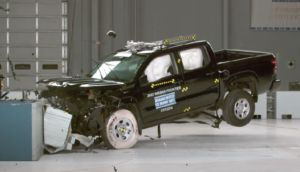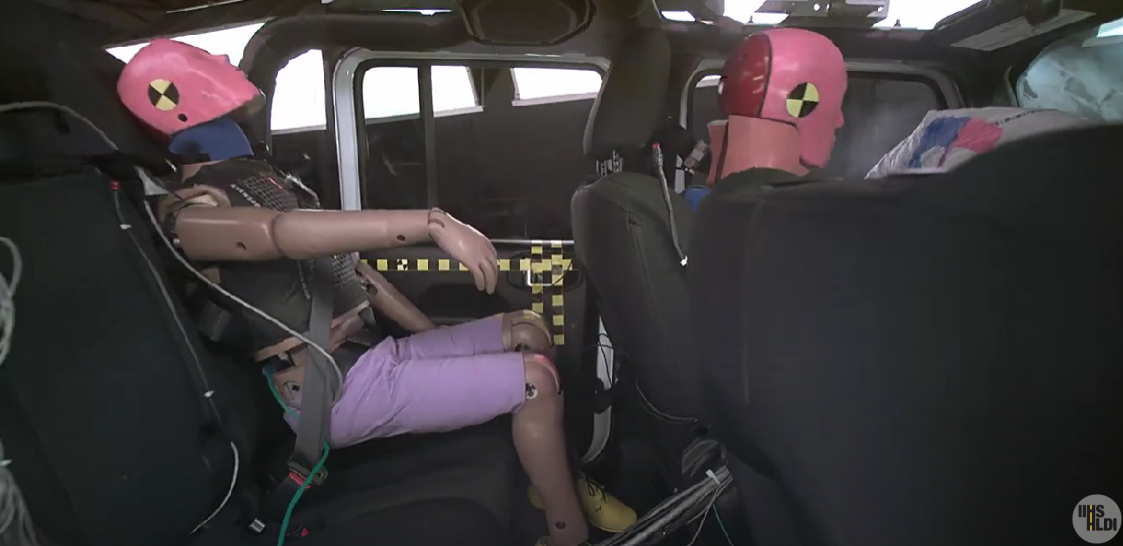
IIHS: Small pickups lack adequate rear seat safety
By onAnnouncements
In the Insurance Institute for Highway Safety (IIHS)’s latest moderate overlap front crash test on five small crew cab 2022 pickup trucks, none earned a good rating.
The Nissan Frontier rated acceptable, Ford Ranger marginal and the Chevrolet Colorado, Jeep Gladiator, and Toyota Tacoma all rated poor. The ratings only apply to the crew cab versions. The trucks fall short in protecting rear seat passengers but not because the rear seats are any less safe than before, IIHS said.
For a vehicle to earn a good rating, there can’t be an excessive risk of injury to the head, neck, chest, or thigh — as recorded by the second-row dummy. The dummy should remain correctly positioned during the crash without sliding forward beneath the lap belt, also known as submarining. The head should also remain a safe distance from the front seatback and the rest of the vehicle interior. A pressure sensor on the rear dummy’s torso is used to check whether the shoulder belt is too high, which can make the restraint system less effective.
All five small pickups provided good protection in the front seat. However, measurements showed a slightly higher risk of leg or foot injuries to the driver in the Gladiator and Tacoma.
In the Colorado, Frontier, Ranger, and Tacoma, the restraints in the back seat allowed the rear dummy’s head to come too close to the front seatback.
That was not an issue for the Gladiator but its rear restraints don’t include a side curtain air bag, which increases the risk of injury from a hard impact on the interior of the vehicle, or possibly, something outside of it.
In the Ranger, the rear dummy submarined beneath the lap belt, causing it to ride up from the ideal position on the pelvis onto the abdomen, which increases the risk of internal injuries.
Otherwise, injury measures taken from the rear dummy indicated a moderate or likely risk of both neck and chest injuries in the poor-rated Colorado, Gladiator, and Tacoma and a moderate risk of chest injuries in the marginal-rated Ranger.
IIHS launched its updated moderate overlap front test last year after research showed that fatal injury risk had become higher for belted rear passengers than for front passengers. The reason is because improved air bags and advanced seat belts are in the front of vehicles while rarely in the back. However, inflating frontal air bags still carry a high injury risk to young children making the back seat the safest place for them, IIHS said.
“Our updated moderate overlap front crash test proved to be challenging for small pickups,” said IIHS President David Harkey. “A common problem was that the rear passenger dummy’s head came dangerously close to the front seatback, and in many cases, dummy measurements indicated a risk of neck or chest injuries. All these things tell us that the rear seat belts need improvement.”
To encourage manufacturers to improve rear seat protection, the updated test adds a dummy in the back seat behind the driver with the driver dummy the size of an average adult man, IIHS said. The rear dummy is the size of a small woman or 12-year-old child. IIHS researchers also developed new metrics that focus on the injuries most frequently seen in back-seat passengers.
In December, IIHS reported that only two out of 15 small SUVs, the Ford Escape and Volvo XC40, protect the rear occupant well enough to earn a good rating.
As in the original test, the structure of the occupant compartment must maintain adequate survival space for the driver, and measurements taken from the driver dummy shouldn’t show an excessive risk of injuries.
Images
Featured image: 2022 Nissan Frontier moderate overlap front crash test (IIHS YouTube screenshot)
IIHS crew cab small pickup truck moderate overlap front crash test rating chart
2022 Chevrolet Colorado moderate overlap front crash test (IIHS YouTube screenshot)
2022 Toyota Tacoma moderate overlap front crash test (IIHS YouTube screenshot)
2022 Jeep Gladiator moderate overlap front crash test (IIHS YouTube screenshot)
2022 Ford Ranger moderate overlap front crash test (IIHS YouTube screenshot)





